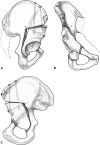Mean 20-year followup of Bernese periacetabular osteotomy
- PMID: 18449617
- PMCID: PMC2505253
- DOI: 10.1007/s11999-008-0242-3
Mean 20-year followup of Bernese periacetabular osteotomy
Abstract
The goal of the Bernese periacetabular osteotomy is to correct the deficient acetabular coverage in hips with developmental dysplasia to prevent secondary osteoarthrosis. We determined the 20-year survivorship of symptomatic patients treated with this procedure, determined the clinical and radiographic outcomes of the surviving hips, and identified factors predicting poor outcome. We retrospectively evaluated the first 63 patients (75 hips) who underwent periacetabular osteotomy at the institution where this technique was developed. The mean age of the patients at surgery was 29 years (range, 13-56 years), and preoperatively 24% presented with advanced grades of osteoarthritis. Four patients (five hips) were lost to followup and one patient (two hips) died. The remaining 58 patients (68 hips) were followed for a minimum of 19 years (mean, 20.4 years; range, 19-23 years) and 41 hips (60%) were preserved at last followup. The overall mean Merle d'Aubigné and Postel score decreased in comparison to the 10-year value and was similar to the preoperative score. We observed no major changes in any of the radiographic parameters during the 20-year postoperative period except the osteoarthritis score. We identified six factors predicting poor outcome: age at surgery, preoperative Merle d'Aubigné and Postel score, positive anterior impingement test, limp, osteoarthrosis grade, and the postoperative extrusion index. Periacetabular osteotomy is an effective technique for treating symptomatic developmental dysplasia of the hip and can maintain the natural hip at least 19 years in selected patients.
Level of evidence: Level III, prognostic study.
Figures






Similar articles
-
Rotational Acetabular Osteotomy for Pre- and Early Osteoarthritis Secondary to Dysplasia Provides Durable Results at 20 Years.Clin Orthop Relat Res. 2016 Oct;474(10):2145-53. doi: 10.1007/s11999-016-4854-8. Clin Orthop Relat Res. 2016. PMID: 27121873 Free PMC article.
-
One-third of Hips After Periacetabular Osteotomy Survive 30 Years With Good Clinical Results, No Progression of Arthritis, or Conversion to THA.Clin Orthop Relat Res. 2017 Apr;475(4):1154-1168. doi: 10.1007/s11999-016-5169-5. Clin Orthop Relat Res. 2017. PMID: 27905061 Free PMC article.
-
Periacetabular Osteotomy Provides Higher Survivorship Than Rim Trimming for Acetabular Retroversion.Clin Orthop Relat Res. 2017 Apr;475(4):1138-1150. doi: 10.1007/s11999-016-5177-5. Epub 2016 Dec 5. Clin Orthop Relat Res. 2017. PMID: 27921206 Free PMC article.
-
Bernese periacetabular osteotomy through a double approach : Simplification of a surgical technique.Oper Orthop Traumatol. 2018 Oct;30(5):342-358. doi: 10.1007/s00064-018-0554-8. Epub 2018 Aug 10. Oper Orthop Traumatol. 2018. PMID: 30097673 Review. English.
-
Periacetabular osteotomy in the treatment of severe acetabular dysplasia. Surgical technique.J Bone Joint Surg Am. 2006 Mar;88 Suppl 1 Pt 1:65-83. doi: 10.2106/JBJS.E.00887. J Bone Joint Surg Am. 2006. PMID: 16510801 Review.
Cited by
-
Developing a novel custom cutting guide for curved peri-acetabular osteotomy.Int Orthop. 2013 Jun;37(6):1033-8. doi: 10.1007/s00264-013-1873-x. Epub 2013 Apr 9. Int Orthop. 2013. PMID: 23568142 Free PMC article.
-
Report of breakout session: Defining parameters for correcting the acetabulum during a pelvic reorientation osteotomy.Clin Orthop Relat Res. 2012 Dec;470(12):3453-5. doi: 10.1007/s11999-012-2426-0. Clin Orthop Relat Res. 2012. PMID: 22777587 Free PMC article. No abstract available.
-
Combined assessment of acetabular coverage and femoral head-neck shapes predicts osteoarthritis progression after periacetabular osteotomy.Arch Orthop Trauma Surg. 2024 Jul;144(7):3083-3090. doi: 10.1007/s00402-024-05439-7. Epub 2024 Jul 5. Arch Orthop Trauma Surg. 2024. PMID: 38967782
-
In Vitro Investigation of Column Fixation Constructs for Periacetabular Osteotomy: Which Provide the Greatest Stiffness and Strength?Arthroplast Today. 2024 Jan 22;25:101291. doi: 10.1016/j.artd.2023.101291. eCollection 2024 Feb. Arthroplast Today. 2024. PMID: 38304245 Free PMC article.
-
Rotational Acetabular Osteotomy for Pre- and Early Osteoarthritis Secondary to Dysplasia Provides Durable Results at 20 Years.Clin Orthop Relat Res. 2016 Oct;474(10):2145-53. doi: 10.1007/s11999-016-4854-8. Clin Orthop Relat Res. 2016. PMID: 27121873 Free PMC article.
References
-
- {'text': '', 'ref_index': 1, 'ids': [{'type': 'DOI', 'value': '10.1302/0301-620X.87B3.15247', 'is_inner': False, 'url': 'https://doi.org/10.1302/0301-620x.87b3.15247'}, {'type': 'PubMed', 'value': '15773651', 'is_inner': True, 'url': 'https://pubmed.ncbi.nlm.nih.gov/15773651/'}]}
- Angliss R, Fujii G, Pickvance E, Wainwright AM, Benson MK. Surgical treatment of late developmental displacement of the hip: results after 33 years. J Bone Joint Surg Br. 2005;87:384–394. - PubMed
-
- {'text': '', 'ref_index': 1, 'ids': [{'type': 'DOI', 'value': '10.1007/s00276-003-0149-3', 'is_inner': False, 'url': 'https://doi.org/10.1007/s00276-003-0149-3'}, {'type': 'PubMed', 'value': '12923665', 'is_inner': True, 'url': 'https://pubmed.ncbi.nlm.nih.gov/12923665/'}]}
- Beck M, Leunig M, Ellis T, Sledge JB, Ganz R. The acetabular blood supply: implications for periacetabular osteotomies. Surg Radiol Anat. 2003;25:361–367. - PubMed
-
- {'text': '', 'ref_index': 1, 'ids': [{'type': 'DOI', 'value': '10.1302/0301-620X.84B4.12495', 'is_inner': False, 'url': 'https://doi.org/10.1302/0301-620x.84b4.12495'}, {'type': 'PubMed', 'value': '11861722', 'is_inner': True, 'url': 'https://pubmed.ncbi.nlm.nih.gov/11861722/'}]}
- Böhm P, Brzuske A. Salter innominate osteotomy for the treatment of developmental dysplasia of the hip in children: results of seventy-three consecutive osteotomies after twenty-six to thirty-five years of follow-up. J Bone Joint Surg Am. 2002;84:178–186. - PubMed
-
- {'text': '', 'ref_index': 1, 'ids': [{'type': 'DOI', 'value': '10.2106/JBJS.E.00339', 'is_inner': False, 'url': 'https://doi.org/10.2106/jbjs.e.00339'}, {'type': 'PubMed', 'value': '16595458', 'is_inner': True, 'url': 'https://pubmed.ncbi.nlm.nih.gov/16595458/'}]}
- Briggs KK, Kocher MS, Rodkey WG, Steadman JR. Reliability, validity, and responsiveness of the Lysholm knee score and Tegner activity scale for patients with meniscal injury of the knee. J Bone Joint Surg Am. 2006;88:698–705. - PubMed
-
- {'text': '', 'ref_index': 1, 'ids': [{'type': 'PubMed', 'value': '3611157', 'is_inner': True, 'url': 'https://pubmed.ncbi.nlm.nih.gov/3611157/'}]}
- Calvert PT, August AC, Albert JS, Kemp HB, Catterall A. The Chiari pelvic osteotomy: a review of the long-term results. J Bone Joint Surg Br. 1987;69:551–555. - PubMed
Publication types
MeSH terms
LinkOut - more resources
Full Text Sources
Medical
Research Materials

